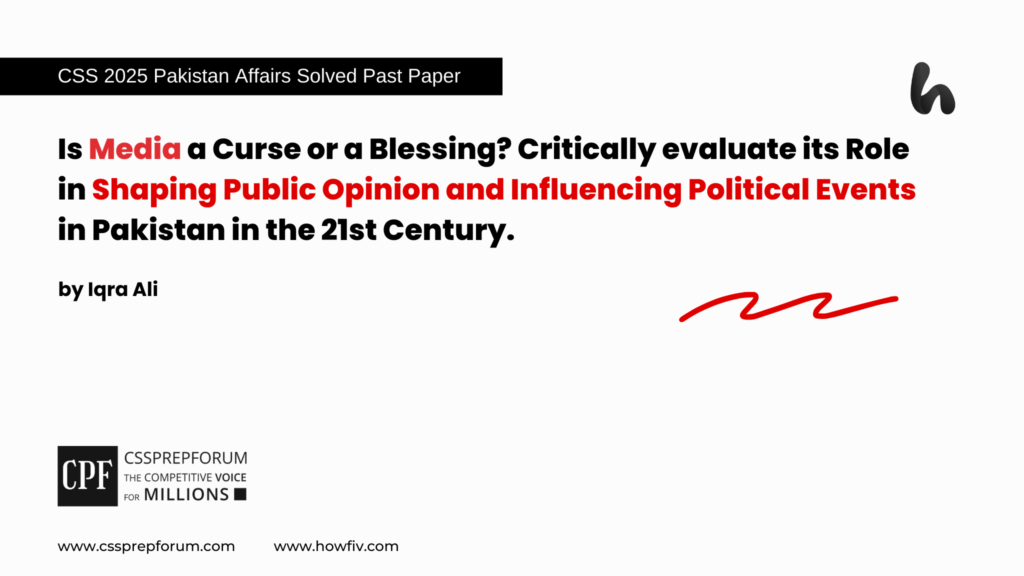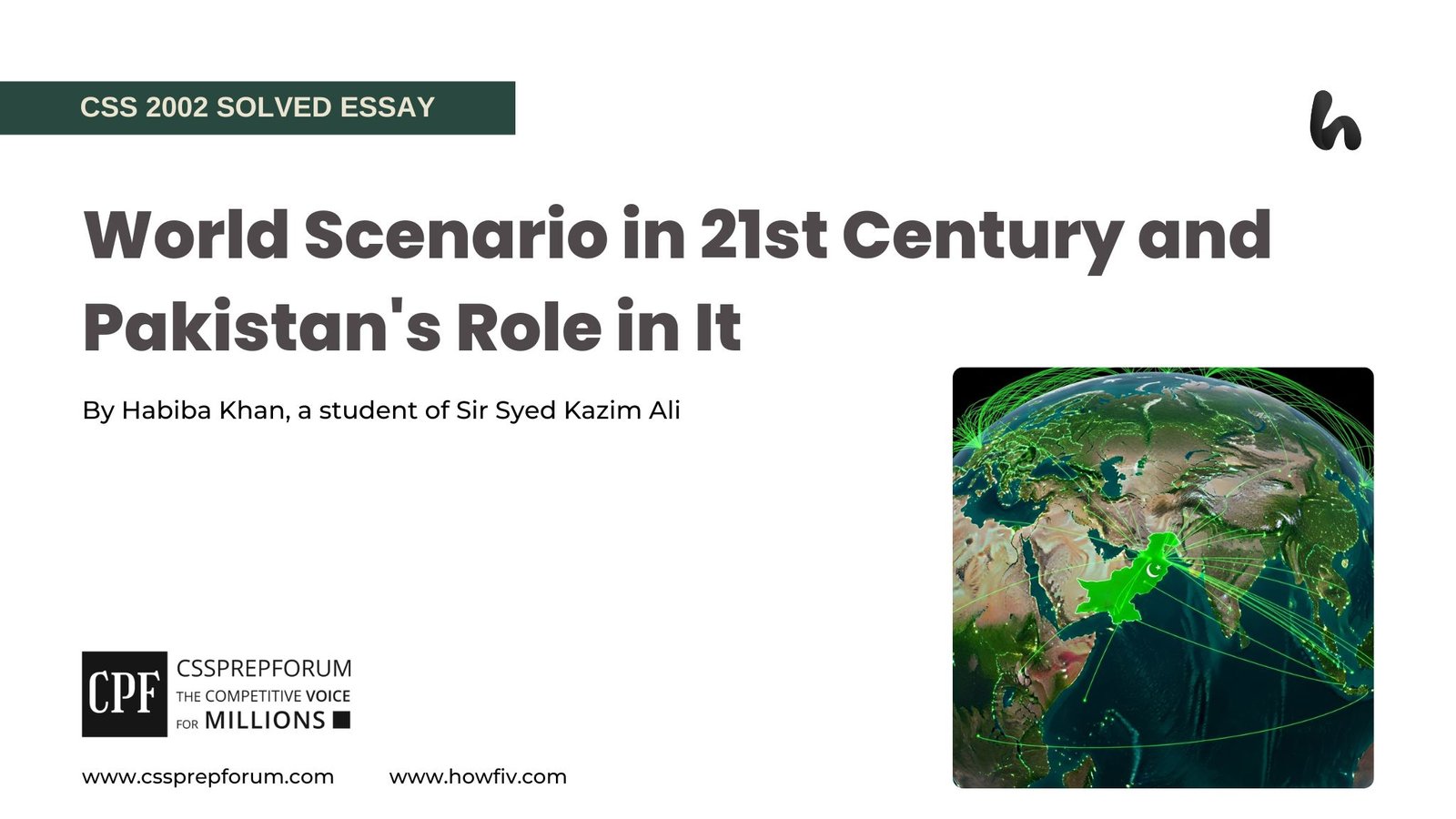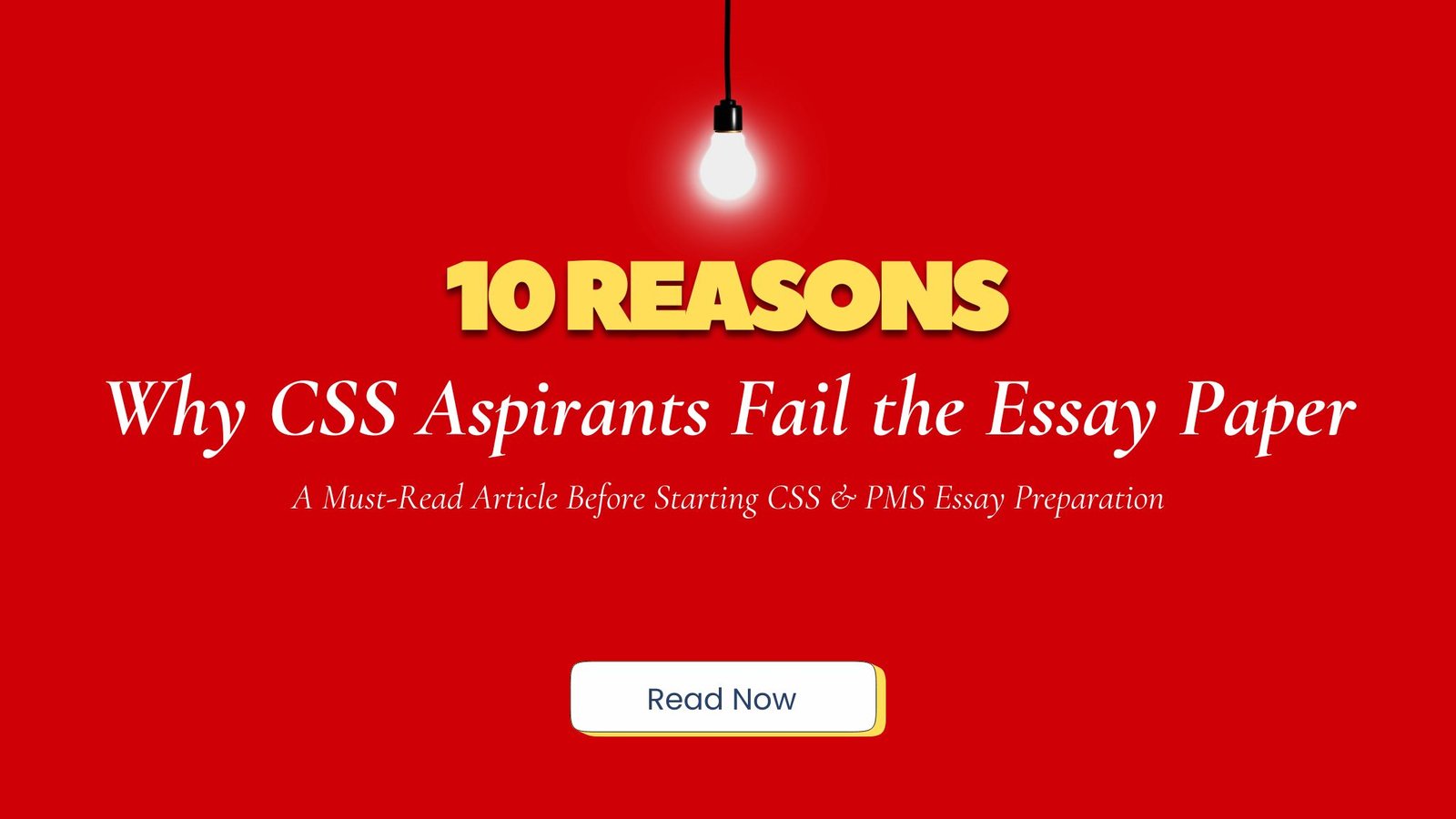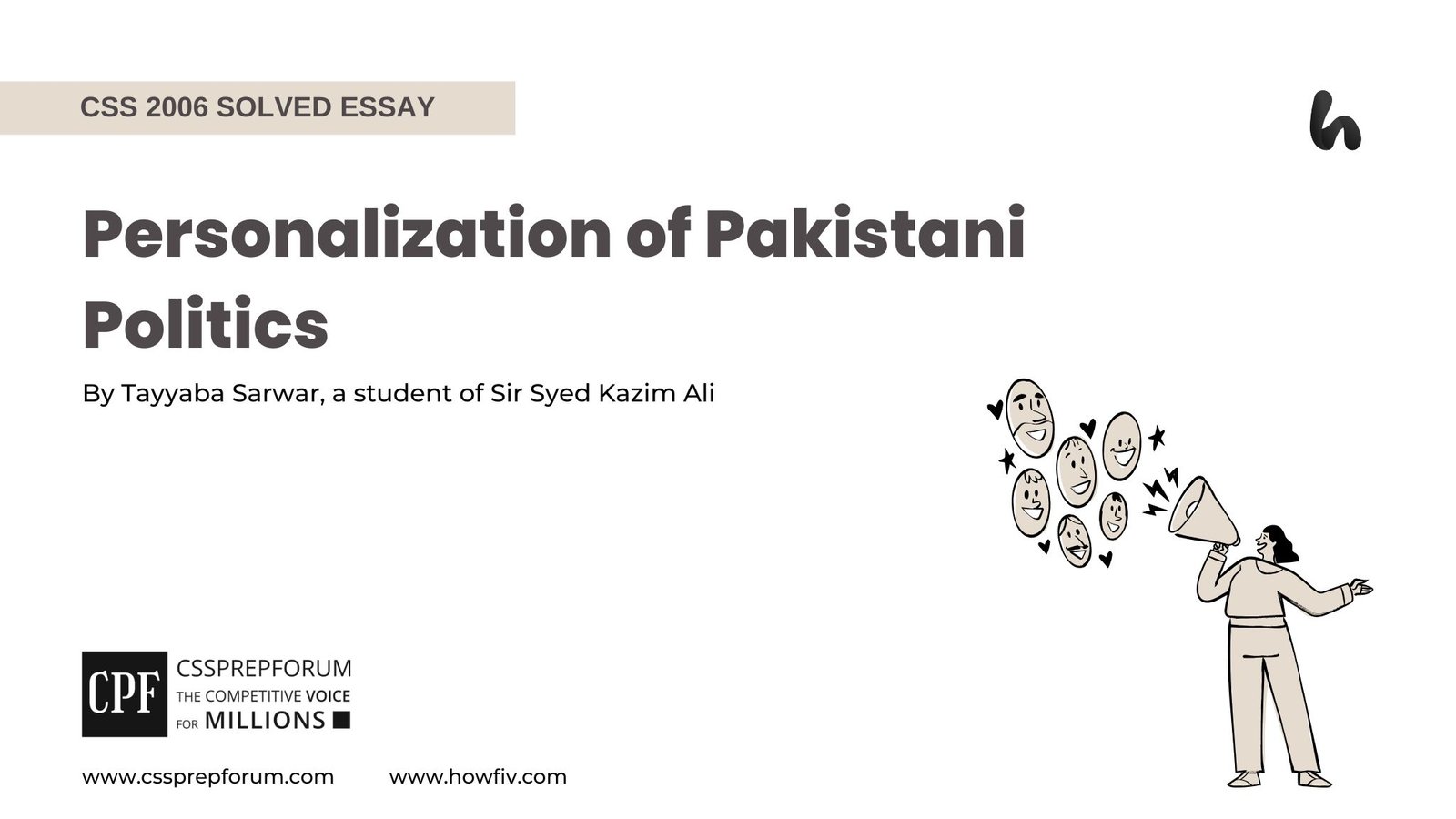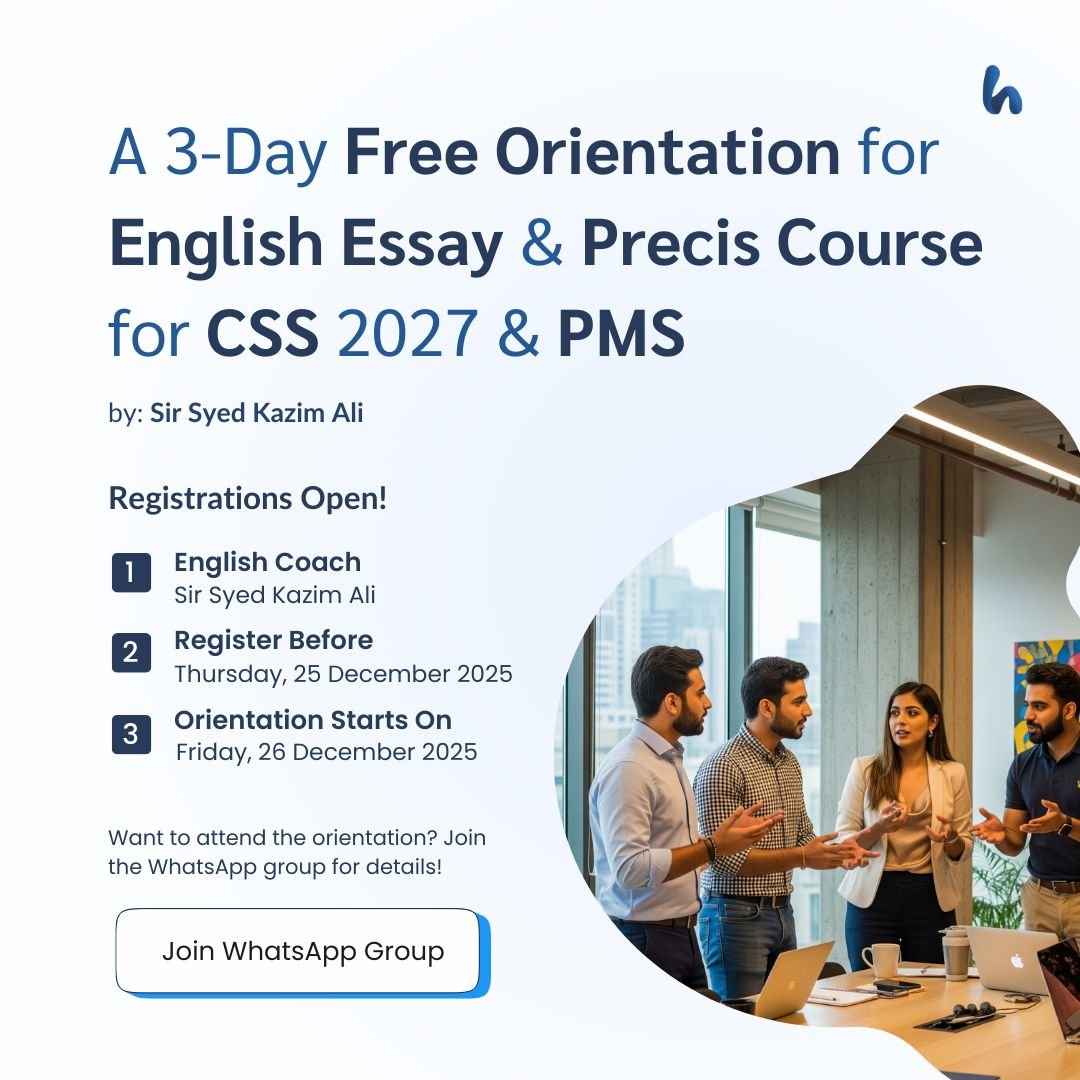CSS 2025 Solved Pakistan Affairs Past Papers | Media and its role in Influencing Politics of Pakistan
The following question of CSS Pakistan Affairs 2025 is solved by Miss Iqra Ali, the best Pakistan Affairs Coach, on the guided pattern of Sir Syed Kazim Ali, which he taught to his students, scoring the highest marks in compulsory subjects for years. This solved past paper question is uploaded to help aspirants understand how to crack a topic or question, how to write relevantly, what coherence is, and how to include and connect ideas, opinions, and suggestions to score the maximum.

Question Breakdown
The question should be critically evaluated with reference to the media’s participation in shaping public opinion and playing a part in Pakistan’s political events in the 21st century. It needs to be viewed in its positive as well as negative aspects, whether media has been a blessing or a curse in Pakistan’s political arena.
Outline
1-Introduction
2-Is Media a Curse or a Blessing?
3-Role of Media in shaping Public Opinions and influencing Political Events in Pakistan in the 21st Century
- ✓Media role in the mobilization of Public support during the Lawyers Movement of 2007-2009 for Judicial Independence.
- ✓The General Elections of 2013 and the Media shaping Political Narratives of the People.
- ✓Media’s amplification of Political grievances during PTI and PAT protests of 2014.
- ✓Media’s key role in broadcasting The Panama Paper Leaks (2016) and influencing Public sentiments against government corruption.
- ✓Media used effectively by Imran Khan to spread anti-corruption messages and influence the public during the campaign and victory of 2018.
- ✓Media is shaping National Policy and Public behaviour during the COVID-19 Pandemic.
- ✓Media and amplification of Political divisions during the political turmoil of 2023.
- ✓Mobilization of Humanitarian Aid during the Flood Crises of 2024 and Pakistan’s Media.
4-Antithesis: Media as a Curse
5-Critical Analysis
6-Conclusion
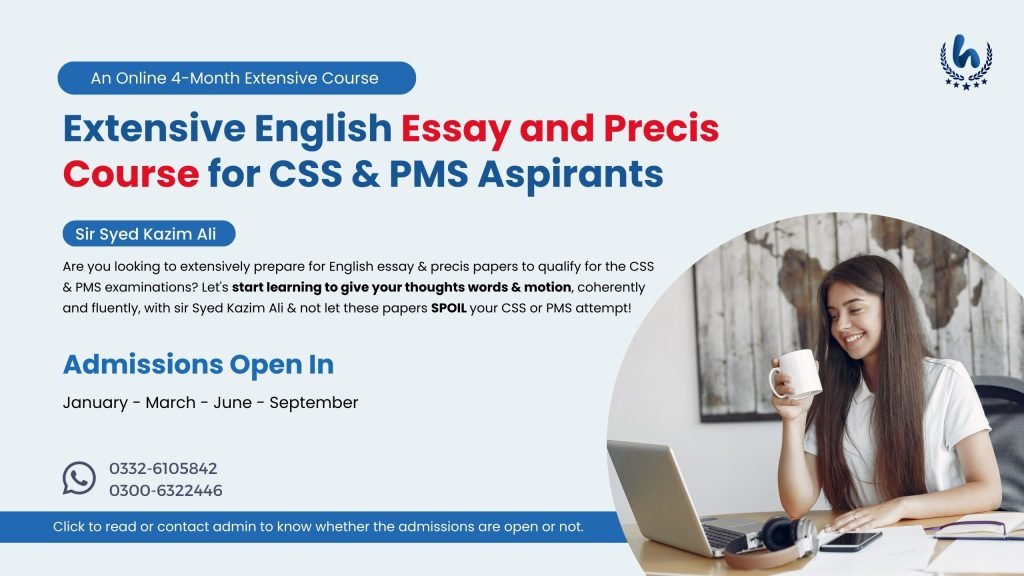
Answer to the Question
Introduction
As a blessing and a curse in modern societies, the media is central to the shaping of public opinion and politics. Media in Pakistan has undergone a transformation from state-controlled broadcasting to a vibrant and variegated media, which includes print, radio, television and digital media. It has been a watchdog of democracy, having exposed corruption to the public, advocated for human rights, and rallied public sentiment in times of crucial political events. It has been a big player of political mobilisation and voter awareness since the Lawyers’ Movement (2007–2009) to the 2018 general elections. Media, though, has its share of weaknesses, such as misinformation, political bias and sensationalism, that could deepen the divide, distort stories and cause public unrest. Media in Pakistan proved to be a divisive tool in 2023, as the political crisis showcased. Responsible media practices are those that hold the power to educate, inform and empower, while irresponsible media practices can erode democratic values. The question critiques whether media in Pakistan is a blessing or a curse, exploring its impact on political events and public perception in the 21st century. Historical events, successes, and failures related to governance, democracy, and social cohesion in Pakistan can be better understood by looking back at key events in Pakistan’s history.
Is Media a Curse or a Blessing?
It has become a powerful force in shaping public opinion, influencing political events and a blessing in disguise for Pakistan. It acts as a watchdog, assuring transparency, accounts and the circulation of important info. According to Marshall McLuhan, “Medium is the message”, bringing out the fact that media affects societal structures and political discourse. The 2007–2009 Lawyers’ Movement was one of the most important media examples of its positive usage, as a number of independent news channels, such as Geo News and ARY, mobilized public support for judicial independence. In the same light, the media acted as a powerful political awareness tool during the 2018 general elections and assisted voters in making informed decisions in choosing candidates. The former Prime Minister of Pakistan maintained his anti-corruption campaign on social media, which also resonated with millions and brought about political engagement on social media platforms like Twitter and Facebook. The media has played an essential role in disaster management and humanitarian aid, most clearly seen during the 2022 floods in Pakistan, where widespread coverage had drawn the world’s assistance. In addition, while COVID-19 was still raging, media outlets were working closely with the government to spread health awareness and combat fake news, as shown by the work of Noam Chomsky in ‘Media Control’ who highlights the role of media in forming and maintaining democratic societies. Challenges like misinformation, censorship, and political bias, however, have not prevented the media from continuing to be a cornerstone of democracy in Pakistan. As Thomas Jefferson declared:
“‘Our liberty depends on the freedom of the press, and that cannot be limited without being lost”’
stating how crucial the press is. A free media with responsibility can strengthen democratic institutions, empower the citizens and create positive political change.
Role of Media in shaping Public Opinions and influencing Political Events of Pakistan in the 21st Century.
- ✓Media role in the mobilization of Public support during the Lawyers Movement of 2007-2009 for Judicial Independence.
In 2007 – 09, the power of the media in Pakistan played a crucial role in the mobilization of public support for judicial independence through the Lawyers’ movement when General Pervez Musharraf disposed of Chief Justice Iftikhar Chaudhry. Live feeds of protests, police crackdowns, and speeches by legal experts have been shown by electronic media such as Geo News, Aaj TV, ARY News, etc. The movement’s demand was judicial independence, and this demand was then turned into a national cause with talk shows hosted by Hamid Mir, Talat Hussain and Kashif Abbasi amplifying it. Investigative reports published in Dawn and The News regarding government pressure on the judiciary sparked nationwide media coverage that culminated in the Long March (March 2009), led by lawyers, civil society and political parties (PTI, PMLN). At first, the government temporarily banned channels like Geo News but then softened the restrictions due to public pressure. Consequently, a historic victory was achieved on March 16, 2009, when Iftikhar Chaudhry was reinstated. A majority of Pakistanis, over 70 per cent as per Gallup Pakistan, backed the judiciary’s restoration primarily as a result of media influence. The media had proved its clout in helping the public to form an opinion and holding the government responsible during Pakistan’s democratic battle.
- ✓The General Elections of 2013 and the media Shaping Political Narratives of the People
Following the 2013 General Elections in Pakistan, the role of the media was a decisive factor in creating the perception among the people and altering the political rhetoric. PML-N, led by Nawaz Sharif, won the first democratic transition of power in Pakistan’s history. Extensive election coverage was given by television channels such as Geo News, ARY News and Dunya News with live debates, party manifestos and rallies. Apart from forming Twitter and Facebook groups, parties, supporters, and journalists engaged in a little bit of political discussions on the two platforms, which became political battlegrounds. The emergence of digital media has been reflected by #VoteForChange and #PakistanElections2013 trends. Gallup Pakistan found that 84 per cent of its urban voters sought information about the election through the TV, and about 30 per cent got news on social media. However, there was a case of media bias as both Geo News appeared to favour PML-N, while ARY News and Bol News appeared to favour PTI. Headlines were dominated by reports of rigging allegations, in particular in Karachi (NA-250) and in Punjab, leading to post-election protests, especially PTI’s electoral reforms demand. The wide coverage in the media helped reach an unprecedented voter turnout of 55%, which was the highest in Pakistan’s electoral history at that point in time. Yet despite criticism of bias and sensationalism, the media was instrumental in voter engagement and political awareness in the 2013 elections.
- ✓Media’s amplification of Political grievances during PTI and PAT protests of 2014.
Major political events in Pakistan include the PTI and PAT protests of 2014, also known as the Azadi March and Inqilab March, in which the media influenced public opinion as well as political developments. Imran Khan, chairman of Pakistan Tehreek-e-Insaf (PTI) and his counterpart Tahir ul Qadri, chairman of Pakistan Awami Tehreek (PAT) staged a months long sit in Islamabad to demand ouster of Nawaz Sharif alleging rigging in 2013 election and alleged killing of PAT workers in Model Town. The protests were widely covered by the electronic media, with ARY News and Bol News supporting the movement and Geo News and PTV accused of being pro-government. Speeches were delivered in live broadcasts, clashes with law enforcement took place and there were crowd movements to keep the nation engaged. Twitter and Facebook hosted #AzadiMarch and #GoNawazGo trends, which helped in fueling political polarization. Gallup Pakistan stated that 64 per cent of people watched the protests on TV, and 40 per cent felt that media had played a part in the crisis becoming more intense. The attack on the headquarters of Pakistan Television (PTV) when some protesters stormed the premises was pivotal as the live broadcast of the assault raised concerns about media manipulation. However, the protests failed to spur immediate electoral reforms, significantly eroding the credibility of the PML-N government while increasing PTI’s popularity with enough time for the latter’s 2018 electoral success. Excessive media sensationalism, however, critics claim, had exacerbated differences instead of helping bridge divides.
- ✓Media’s key role in broadcasting The Panama Paper Leaks (2016) and influencing Public sentiments against government corruption.
The Panama Papers leak (2016) was a defining moment in Pakistan’s political history, and the media was at the centre as it exposed corrupt practices and created public opinion. Published by the International Consortium of Investigative Journalists (ICIJ), the leaked documents linked former Prime Minister Nawaz Sharif’s family to offshore companies and undisclosed assets. The scandal was made a central issue of political discourse and Pakistani media had extensively covered it. The revelations were continuously debated by television talk shows, particularly by Geo News, ARY News and Dunya News, which invited legal experts and opposition figures to talk about their effects. The story of corruption is getting flogged on Twitter by #PanamaLeaks and #NawazCorruption tags. Pakistan survey showed that 77 per cent of Pakistanis thought corruption was widespread in the country, and the public resentment on the issue further mounted. The Supreme Court of Pakistan was forced to act due to the constant coverage by the media. All major news outlets publicized, leading to the disgrace of Nawaz Sharif under Article 62(1)(f) of the Constitution for not disclosing assets in 2017. This undermined PML-N to a great extent, and thus, the 2018 elections were won by PTI riding on an anti-corruption wave. The Panama Papers saga showed how powerful media can be in shaping political events and forcing leaders to account, but critics argue that some media outlets were biased in their reporting.
- ✓Media was used effectively by the former Prime Ministers to spread anti-corruption messages and influence the public during the campaign and victory of 2018.
In the 2018 general elections, the media helped in setting the public mood that pushed Imran Khan and his Pakistan Tehreek-e-Insaf (PTI) party to victory. Television channels, newspapers and social media helped to amplify an anti-corruption narrative, which helped to mobilise support against traditional political parties, especially the Pakistan Muslim League Nawaz (PML-N) and the Pakistan Peoples Party (PPP). Imran Khan’s stance against corruption figured prominently in television news in cases ranging from the Panama Papers scandal that secured him the disqualification of former Prime Minister Nawaz Sharif in 2017. Political analysts and talk shows in Pakistan strengthened the view that PTI was bringing clean politics, ending dynastic politics, and curbing corruption, thereby constituting a ‘new Pakistan.’ The survey also shows the effectiveness of this media driven narrative, as more than 64% in Pakistan believe corruption to be the biggest issue in elections of 2018. Social media also contributed to PTI’s digital media team running hard campaigns with hashtags such as #TabdiliAagaiHai (Change has come) and #CorruptionFreePakistan. The viral videos of Imran Khan’s speeches targeting the ruling elite reached millions, particularly the youth. Just before the elections, the number of engagements on PTI’s official pages on Facebook and Twitter skyrocketed as millions began interacting with the Federal government’s social media presence. Uncertain voters were swayed by the media’s imagery of PTI as a clean, revolutionary party. Thus, PTI bagged 115 National Assembly seats to form a government in alliance with other parties. However, the media definitely played a role in the political landscape, and the 2018 elections were historic in Pakistan’s democratic history.
- ✓Media is shaping National Policy and Public behaviour during the COVID-19 Pandemic.
In Pakistan, the media was the pivotal factor in helping spread public behaviour and affecting national policies during the COVID-19 pandemic. However, with the virus making its way in early 2020, the Pakistani government and health authorities heavily relied on television, newspapers and social media to spread information about preventive measures, lockdown policy and vaccination drives. Pakistan’s response was coordinated by the National Command and Operation Center (NCOC) established in March 2020. It frequently held press conferences and media briefings for families, community participants and the general public alike, giving real time updates of case numbers, hospital capacities and Standard Operating Procedures (SOPs). These messages were, of course, spread in the media, telling the public to wear masks, to stay away from one another, and to get vaccinated. Additional social media platforms such as Twitter and Facebook also contributed. Office closures, closures of flights, and the hashtag #StayHomeStaySafe from all corners of Pakistan were spreading awareness. Moreover, digital platforms drove against misinformation, for instance, rumours that vaccines cause infertility and that COVID-19 is a hoax. Media channels were used to debunk these myths by influencers as well as by health experts, including Dr. Faisal Sultan, then Pakistan’s health advisor. A 2021 Pakistan survey indicates that television was the source for 78% of Pakistanis’ COVID-19 updates, while 55% of Pakistanis relied on government briefings. By 2022, Pakistan had administered over 250 million doses as a result of this media driven information campaign, a first in the history of the country.
- ✓Media and amplification of Political divisions during the political turmoil of 2023
The year 2023 was a year of political tumult in Pakistan, where former Prime Minister Imran Khan was arrested, and his supporters raged in the streets. The media was equally important in amplifying political divisions, influencing public opinion and making a dent in the political landscape. Battlegrounds for competing narratives, traditional news channels, social media platforms, digital news outlets, and the rest of the media became more polarized. Violent protests erupted across the country after Khan’s arrest on May 9, 2023. Social media played a crucial role in mobilizing support in the media’s extensive coverage of clashes between law enforcement and protestors. Videos of police actions and allegations of human rights violations filled up platforms such as Twitter, Facebook and YouTube. Independent journalists examined crackdowns carried out by the state, while in pro-government media houses, the opposition is accused of pushing for violence. Dawn reported that more than 3,000 protestors were arrested, and several military installations were attacked during the unrest. Under pressure from the backlash from Pakistani citizens’ statements on social media, the Pakistani government declared an internet blackout and limited access to major social media platforms to contain the spread of dissent. Widely criticized by human rights organizations such as Amnesty International, this was an attack on freedom of expression. This crisis was double-edged for the media as it was to update the world with the happenings and to uncover government excesses, but it also spread misinformation and extended existing political divides.
- ✓Mobilization of Humanitarian Aid during the Flood Crises of 2024 and Pakistan’s Media.
In 2024, monsoon floods hit Pakistan, with many parts of Balochistan, Punjab and Sindh affected. During this crisis, humanitarian help was facilitated by the media. National and international outlets offered extensive coverage of the plight of affected communities and brought the disaster to the attention of the international community. The widespread reporting was critical in rallying domestic and international support. The United Nations Office for the Coordination of Humanitarian Affairs (OCHA) in Pakistan itself was involved in strengthening the capacity of government partners and local organizations to meet the needs of affected populations. Media channels augmented their efforts to relay critical information to policymakers and the public. The underfunded international relief response was reported to be a weakened effort compared to previous disasters, given that grant-based contributions fell short of previous disasters. It highlighted our need to maintain media advocacy to keep the crisis in the public eye and ensure further support. Overall, the role of the media during the 2024 floods was instrumental in spotlighting the disaster’s severity as well as helping humanitarian relief efforts and pleading for long-term resilience tactics to reduce future climate change inducement calamities.
Antithesis: Media as a Curse
Unchecked and misused Media has been a curse in Pakistan, it has played a catalyst of misinformation, political instability and divide in the society. In much the same way, journalistic integrity has eroded, to be manipulated rather than informed, leaving sensationalism, fake news and propaganda driven reporting to rise. In recent years, media houses have increasingly set themselves up on the side of political or financial interests instead of leaning on objectivity in favour of ratings and influence. A 2023 report by Freedom House notes that Pakistan’s media is on the “Partly Free” level because of biased reporting and external pressures. The 2022 political crisis is a perfect example of creating disinformation campaigns through television channels and social media in order to spread fake news, stir up protests and destabilise governance. The 2014 PTI-led sit-in also saw a lot of media coverage that polarized the public. Further; some channels were openly favouring some political parties. Digital misinformation is another significant concern, as throughout the COVID-19 pandemic, false information regarding vaccines and treatments spread quickly, creating confusion and fear among the public. Media also has played a role in strengthening sectarian tensions and propagating extremist ideologies. Provocative media coverage for the 2021 protests of Tehreek-e-Labbaik Pakistan (TLP) sparked violent clashes. The cyberbullying and defamation that have made social media platforms its breeding ground have affected not just ordinary people but also political figures, journalists, activists and many other personalities. In the end, rather than being a pillar of democracy, the media in Pakistan has often been used to control the narrative, manipulate opinion and destabilize an institution. But without strict regulations and ethical journalism, its benefits cannot outweigh that negative effect and it instead becomes a dangerous tool rather than a democratic asset.
Critical Analysis
Undeniably, media in Pakistan has become a double edged sword serving as an agent of positive change and a tool of manipulation, the same media that gives people power can also mislead them. Man’s credibility with the media has been seriously eroded by the rise of disinformation, political bias, and sensationalism. Media continues to be a source of empowerment and frustration from a public perspective. While there are many who like its spotlight on corruption and the amplification of voices in the public, others find themselves disillusioned about how neutral it appears. While the public has an inherent trust in media, that trust shrinks when it’s obvious that some outlets make decisions based on ratings and political motivations rather than journalistic ideals. Free and independent press is vital for the democratic process; however, it has to be done in an ethical way and balanced by regulatory mechanisms to avoid misprint. Also, the public is less susceptible to manipulation if they are encouraged to become media literate so that they can avoid being manipulated. A journalist’s character, a media house’s responsibility and public awareness would play the defining role in the future of media’s role in moulding political events in Pakistan.
Conclusion
Throughout the 21st century, the media has played an undeniable role in shaping public opinion and influencing political events in Pakistan. It has been a powerful tool for information dissemination, utility, political awareness and government accountability. Media has watched over corruption scandals, rallied people during the crisis, and served as a bridge between the state and the people. With the advent of digital and social media, its influence has been amplified further and citizens can now participate actively in political discourse with instant access to information. Finally, media is neither inherently a curse nor an absolute blessing; it is a tool and it is the way it is used that determines its effect. Media has a vital role to play in Pakistan’s democratic evolution, therefore, responsible journalism, ethical reporting and media literacy within the public are crucial so that media continues to be a force for the good.
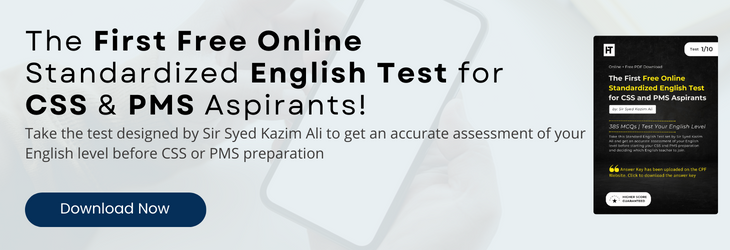
CSS 2025 Solved Pakistan Affairs
| 2- | How did the Indus Waters Treaty (1960) affect water distribution and relations between Pakistan and India? |
| 3- | Examine the causes and consequences of the 1971’separation of East Pakistan, highlighting the role of regional and international players. |
| 4- | Explore the significance of CPEC (China-Pakistan Economic Corridor) for the economic development of Pakistan. What are its (potential challenges and opportunities? |
| 5- | Analyze the demographic and cultural diversity of Pakistan and its impact on national integration and policymaking. |
| 6- | Critically evaluate the impact of Bhutto’s nationalization policy on the economy of Pakistan. |
| 7- | The Kashmir dispute is an unfinished agenda of the 1947 partition. Evaluate Pakistan’s Kashmir policy for the solution of the problem. |
| 8- | Is media a curse or blessing? Critically evaluate its role in shaping public opinion and influencing political events in Pakistan in the 21st century. |
CSS Solved Past Papers’ Essays
Looking for the last ten years of CSS and PMS Solved Essays and want to know how Sir Kazim’s students write and score the highest marks in the essays’ papers? Then, click on the CSS Solved Essays to start reading them.
CSS Solved Essays
CSS Solved General Science & Ability Past Papers
Want to read the last ten years’ General Science & Ability Solved Past Papers to learn how to attempt them and to score high? Let’s click on the link below to read them all freely. All past papers have been solved by Pakistan’s top CSS GSA coach having the highest score of their students.
General Science & Ability Solved Past Papers

